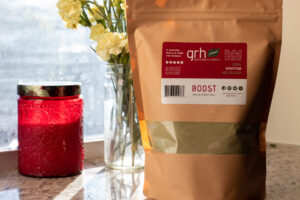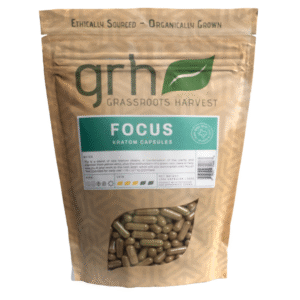Mitragyna Speciosa Korth is a plant. It’s a member of the Rubiaceae family, which also includes coffee. It’s a tropical tree indigenous to the South East Asian region. This 4 – 16-meter-high tree was originally in New Guinea and the Philippines. Since then, we know it is also in other regions like Thailand. In Thailand, Mitragyna Speciosa also goes by Kratom. Today, Kratom or Mitragyna Speciosa is popular all over the world for its potential benefits which we will expand on later.
[product-block]
Traditionally, kratom leaves (dried or fresh) are chewed or made into tea and not smoked. Grinding kratom into a powder form is common, as is adding the powder to capsules. At low doses, Kratom provides stimulating effects and works great when combatting fatigue during work hours. At even higher doses, it may have sedating effects making it useful for users looking to relax or alleviate stress.
Within Mitragyna Speciosa, there are over 40 structurally related alkaloids, multiple flavonoids, terpenoid saponins, glycosides and various polyphenols. These isolated phytochemicals are responsible for Kratom’s effect on the body. Of these compounds, the major components found in the leaves are mitragynine and 7-hydroxymitragynine, both found only in Mitragyna speciosa.
Known as the alkaloid with the largest presence found within Mitragyna Speciosa. It was first discovered in 1921, and its chemical structure was fully understood in 1964.
Mitragynine does not dissolve in water but it dissolves when placed in other organic solvents including but not limited to alcohols, acetic acid, acetone, chloroform and diethyl ether providing fluorescent solutions. This compound distils at 230–240 °C at 5 mmHg and it creates white, amorphous crystals that melt at 102–106 °C. The melting point of mitragynine hydrochloric acid salt is 243°C; the picrate melts at 223–224 °C and the acetate at 142 °C.
This compound was identified in 1993 and its molecular formula is C23H30N2O5 and its molecular weight is 414.50 g/mol.
There are multiple benefits that may come taking Kratom, these include the following:
Mitragyna Speciosa may be helpful for those dealing with stress. It does this by its mitragynine compound which calms the brain nerves down. Mitragynine interacts with opioid receptors in the brain. It has calming properties with few side effects and it allows you to stay calm and remain relaxed throughout the day. In addition to this, Mitragynine hits your body immediately creating instant relief once it gets to your system.
Mitragynine has opioid-like properties and this makes Mitragyna Speciosa very unique to helping discomfort. Certain Kratom strains in particular have unusually high number of alkaloids and these enhance its analgesic properties and making it an excellent way to reduce discomfort. A better way to put it, may be this. It may work like a painkiller, but without any of the negative side effects they may possess.
Finally, Mitragyna Speciosa may also have soothing properties which help to reduce your stress levels, improves your energy levels, and function as an antidepressant. It also provides support to users dealing with discomfort or looking for help with their mood.
It is not strange to find arguments over word pronunciation. Water, potato, tomato and so on have led to numerous debates and even more Tik Tok videos. And although the difference often rests within accents and languages, does that make a pronunciation better than another?
Kratom is the latest word to evoke such debate. The naturally occurring supplement may aid the wellness of millions around the world. But many are still wondering- how to pronounce kratom?
Depending on where you live, odds are the most common pronunciation of Kratom you use is either KRAT-tom or KRAY-toom. So what is the best way to pronounce kratom?
KRAT-tom
Kratom pronounced, KRAT-tom or KRAT-um. A similar pronunciation to ‘atom’ makes use of an ‘a’ sound for the A rather than a pronounced ‘ay’. Considering the fact that most languages use this short ‘a’ as opposed to the longer ‘ay’ sound, this is the more common way of pronouncing the word Kratom.
KRAY-toom
KRAY-toom or Kray-tum is similar to the word ‘Tatum’ which makes use of the long ‘ay’ sound instead of the short ‘a’ for the a. This is the more common word pronunciation format in the United States because of the predisposition of users to already use the longer ‘ay’ as opposed to the short ‘a’

Truth is there is no one correct way to pronounce the word ‘Kratom’. Too many factors come into play making it almost impossible to dictate what pronunciation is right and which is wrong. Basic pronunciation rules might point to KRAY-tum but the pronunciation of many other words could suggest KRAY-toom is more appropriate. Factoring in accents put a further spin on how ‘a’ is pronounced. That leads to even further variations of pronunciation of the word kratom.
Within the community, some veterans insist that KRAT-um is the correct kratom pronunciation while leading institutions make use of KRAY-tum when referring to the supplement.
It is also interesting to note that numerous members of the community believe that the pronunciation of the plant’s name in its native countries should be taken into account when the right pronunciation of the word in English is up for discussion.
English speaking kratom users might be in conflict on how to pronounce kratom. But in its native dialect, its name is something entirely different. In its native Southeast Asia region, Kratom is often referred to as keturm, with the ‘r’ being silent in most local pronunciations especially in Thailand. Furthermore, the substance has even more names depending on the region you find yourself in.
At the end of the day does it matter how you pronounce kratom? To be honest, not really. As long as you are able to let people know what you are referring to, it is perfectly okay to pronounce the word in just about any way you are able to.
Shop premium kratom products here!
[post-button]



